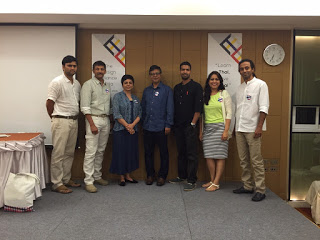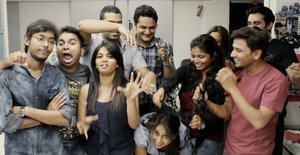Asia Meet: A Dialogue in Bangkok
The Design Alliance Asia recently held an “Asia Meets” event in Bangkok. The meet saw a sharing of thoughts and discussed the flow of design in Asian countries. Design team from Elephant reflects on a few insights learnt from the meet.
Designers In conversation
ASHWINI DESHPANDE, ANAND PALSODKAR, MAYURI NIKUMBH, SHRISH TILEKAR, PRASAD KENKRE, PARTHO GUHA & ASHISH DESHPANDE
STATE OF DESIGN IN ASIA
Anand:
As I think about state of Design in Asia at a larger level, one wouldn't agree more with Thomas Friedman when he says that 'The world is flat' and perhaps becoming flatter as we head towards the future.
Prasad:
If one utters the word design, none of the Asian countries actually come first to our mind. Mostly European countries like Germany, The Netherlands are strongly associated with design. Design as a field in Asia still largely remains misunderstood to the vast amounts of population. “Design is vast and covers everything from ceramics to aeronautics is Design”.
Shrish:
Since the Asian culture is deeply rooted with history of several years, it vastly differs in religion, language and beliefs. Most of the design, hence, is a result of very long evolution within each of these diversities. This evolution and diversity of design is very evident in all its forms, like architecture, town planning, products and so on.
Partho:
The economy in South East Asia is presently in a depressed state and design profession and projects are affected by it. Design projects around real estate development are on the rise and interesting design projects are happening there. Asian Designers are quite evolved in terms of new principles and expressions in the cutting edge of design. Be it use of Design Thinking process or innovation in social media expressions, Asian
Designers are more vibrant and much extent leading the world.
Mayuri:
If one considers professional design practiced by Asian designers, the scenario is very promising and there are clear indicators of intense & original thinking, well-set processes and excellent execution being carried out. However, design percolating in everyday lives and its environment, is still a dismal situation. There is an absence of sensitivity towards the visual landscape. There seems to exist a parallel set of worlds, where design on one hand is shiny, digital and larger than life world heavily influenced by modern Orient and on the other hand there is the imagery and essence inspired by traditional elements, architecture and practices.
Ashish:
There was a period in Asia when internal consumption was limited, mainly, due to poor economic conditions. Countries had to look west for technology & markets. Today, Asia is changing. Asian markets are strong & local consumption can sustain economies. Most Asian countries gave up their habits, customs, and traditions in the period between 1950-1990 and aligned themselves to the developed world. However, there is a noticeable shift seen. Design in Asia seems to be aligning itself back to its roots and the results are astonishing.
Shrish:
While it is great to see and experience such diversity in design, at times it can also become very selfish. It gets too restricted to a particular type of people or a section of the society, while in its true sense it should be enjoyable by all. Coming from cultures with such deep roots, we often lack the vision to look beyond all these boundaries to create a holistic and global design.
Ashwini:
Design as an organized, professional activity or service is nascent in most of Asia. In places it has taken shape from strong cultural art such as calligraphy or traditional materials such as bamboo or handloom textiles. However, all the mass produce design took its inspiration from the west, which as that part of the world was a front-runner in industrial development.
INFLUENCE OF LOCAL CULTURE
Mayuri:
It was heartening as well as inspiring to see a lot of influence of local culture and traditional forms in modern day design. The Arabic typography projects shared by Designer
Tarek Attresi, drew a lot of inspiration from local calligraphy & markings, yet is global & contemporary. Traditional objects from local culture creatively inspire designer Pham Huyen Kieu’s, Haki Craft objects.
However, the corporate work done is very much global in approach & appearance. The bank branding done by Color Party, Thailand or the
products designed by NDD Design, Taiwan are truly global.
Ashish:
Yes, Design inspiration can stem from traditions & customs. However, in Asia, it also draws from local needs & economic conditions. That is why many times to make economic sense, design needs to have a universal appeal. Design & Designers in Asia tend to play a dual role. You see this prominently in Colour Party, Thailand or NDD Design, Taiwan work. However, William Harald Wong, Malaysia museum design draws sensibly from local folklore & crafts. The same can be said about the Book project shared by Subrata Bhowmick.
Shrish:
Evolution is still continuing around the same factors like traditional habits, religion. The original essence of the design is maintained to a certain extent making it very local and specific to particular region or country.
Prasad:
Design needs to solve problems. If a designer does not understand the culture of the people for whom he or she is designing, then it is sure to end up creating more problems. Understanding local culture, language, lifestyle of people and its nuances is critical. A designer fails if he is Insensitive to this and does not make a genuine attempt to actually understand culture and the people in context of the problem.
Shrish:
Though the problem would remain the same it is simply astonishing to see various solutions we would have in different parts of the country or the continent. These solutions are derived form the local culture, behavior and beliefs of people. The long-term solutions that would require a global and holistic approach often get neglected resulting in local design and design approach.
Partho:
It is still a challenge for Asian designers to align their solution to the cultural ethos and principals. Most of the culture led design, incorporates certain traditional motif and patterns in their solutions very successfully.
Anand:
Profession of Design has always functioned as a reaction to the needs
& aspiration of people, markets and technology. Aspiration of people is still largely driven by what happens in the Western world.
Developed countries have always been on the forefront of technology and design. Design in Asia seems to follow “the west”.
Leading brands today develop their markets based on the 'economy' of the geographies and design simply caters to that. So in such cases, I see very little or no influence of culture or region on Design in Asia at least as far as Industrial Design goes. Not sure if this is a point of concern or not, but it surely is reflection of The Flat World.
Ashish:
Let me take a few examples. The Rattan chair designed by late Irvan Noe’man, BD+A which received Good Design Mark, Japan and the Bhoomi pot series designed by Elephant, India are good examples of Industrial Design drawing influence from local crafts, customs. Freeman Lau’s chairs and much of the package design work by KL&K, Hong Kong are classic contemporary interpretations of regional crafts and customs.
Anand:
In 50s, Honda developed a motorcycle ('step through' segment) for SE region catering to the local needs of traditional clothing (read culture), muddy &
bad roads and affordability. This was a huge success. Today after many years the segment is still very popular, albeit people who do not dress traditional, have smaller families and road conditions are far better than in the past.
FUTURE OF DESIGN FOR ASIA
Shrish:
The problem of integrating local design with global approach must be taken up very seriously and in a very effective way.
Prasad:
Design in Asia has slowly but surely started getting recognition. Increasingly more and more governments have started noticing the changes that design can make. They are actively promoting design like the example we saw at TCDC in Bangkok. It also very strong in Hong Kong through Hong Kong Design Centre and various organisations & activities. This is a Positive step.
Mayuri:
The future of Asian design is on the right path of becoming a strong element in the DNA of big corporates. However, there is a need to stay rooted and retain our identity in design expression wherever possible. There are of course cases when design solutions are required to be more universal or westernized but eventually Asian designers are predominantly designing for Asian consumers and we need not ape western concepts blindly. Each Asian country has its own unique quirk and character. Designers here are trying their best to retain or imbibe these in their design solutions. If we keep at it, Asian design can really make its own mark and be recognized for its own brand of design, else the boundary between design sensibilities across borders and continents will keep merging and Asia will be seen as cookie cutters!
Ashish:
Asia presents a brilliant opportunity for designers. Take example of Hugh Hu of NDD Design, Taiwan, who has been curating design efforts by local Taiwanese Designers to draw from traditional habits & crafts to design objects with new meaning. Staying rooted with new meaning is one of the path.
Shrish:
As a result of being Asian, I see design making a great mark in the world. Asian design ranges from very complex and intricate designs to a very minimalistic design approach and this variety is gaining popularity worldwide. Strong traditional and regional influence coupled with a global approach will make the proposition very interesting and unique. This approach to use the power of design to create change may start a revolution that will affect the lives of each and every person in Asia in a very big way.
Prasad:
However, Design in Asia should focus on solving developing world problems e.g., Lack of Sanitation, maximizing with limited resources. Designers underestimate the Power that Design can make if it solves a single Problem. The implications are humongous as millions of people can be effectively affected by a single design intervention.
Design in Asia is definitely moving forward, albeit at a snails pace and lots still needs to be done to make design gets its due.
Partho:
The learning from the west is more or less complete and now there is a lot more respect for culture influenced design. Keeping with the overall cultural progression of Asian societies, expression around traditional mixed with western is emerging. Other cultural expressions like Music, Cinema, Painting, Writing in Asia is following a similar path. Overall Asian design is maturing and ready to take on a new path, which is culturally deep, technologically expressed and relevant to modern way of living.
Elephant is India’s Best Design Practice (ET-Brand Equity 2012-2014 ranking) with a multi-disciplinary experience of 25+ years having presence in India & Singapore and has been transforming brands, organizations & businesses using Design led Innovation. Apart from being a thought leader in the field of design, especially in emerging markets, Elephant has made significant contributions through design to Paperboat, Symphony Appliances, Bennett University (TOI Group), Axis Bank, City of Pune, Britannia, MultiX, V Wash, VOOT and even social initiatives like Pune Bus day, Sakal Group amongst several others.


























